#Artemisia Gentileschi
Explore tagged Tumblr posts
Text

9K notes
·
View notes
Text
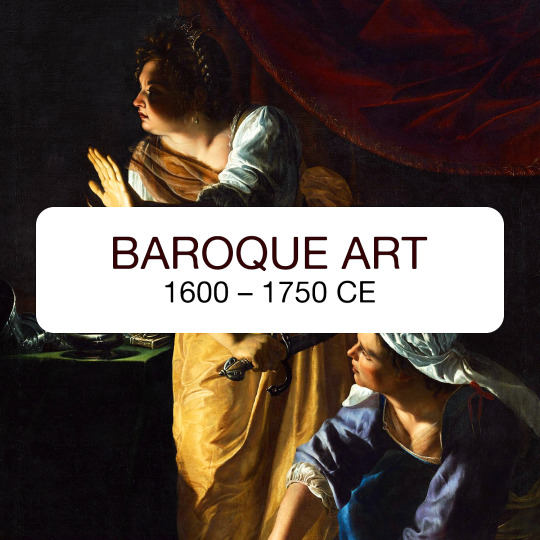
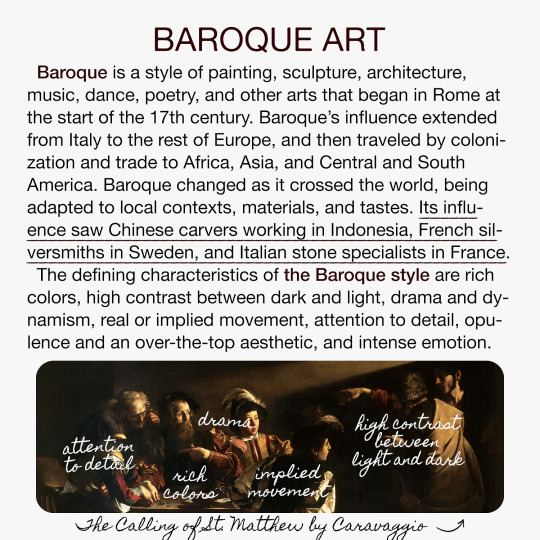
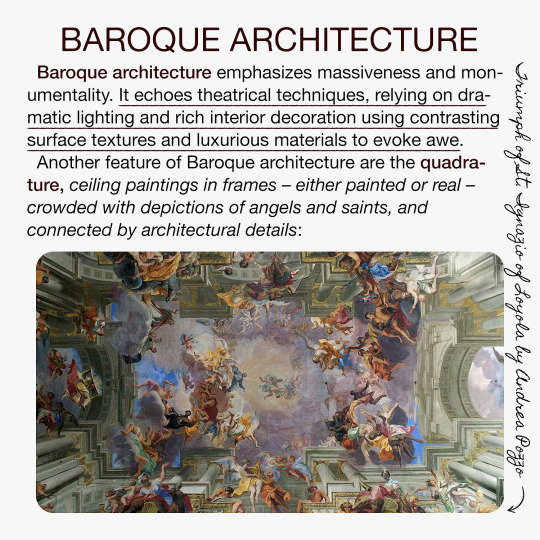



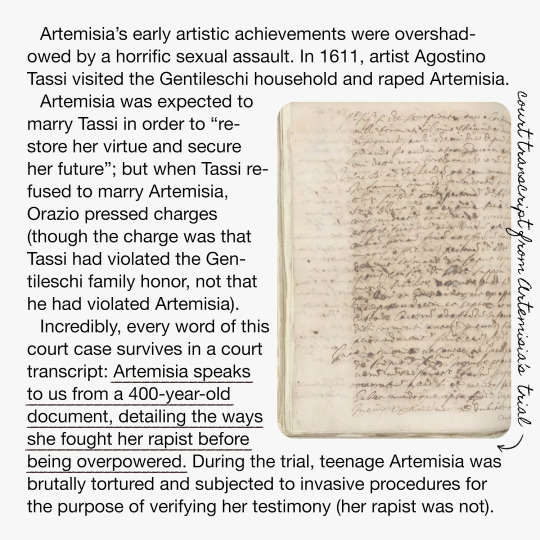

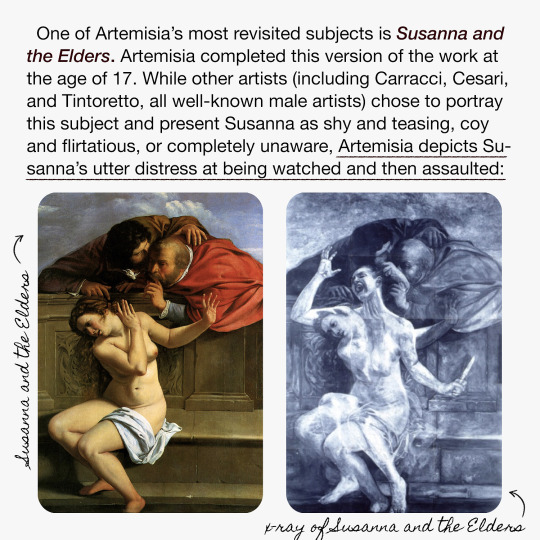


BAROQUE ART 🎭 love, ur local art mom 🩵
disclaimers and more information under the cut ✂️
hi I’m annemarie and I’m an art historian! not adjuncting for the first time in five years was rly hard for me so I threw some slides together so I could still (sort of) teach the same material as my language of art class but a) I threw these slides together for instagram so space was/is limited and b) language of art is a ten week run through art history so I’m presenting only the most accessible information here – there’s so much more to this art period and to this artist! – please don’t expect it to be comprehensive and please do ask if you have any questions!
oh p.s. my first ever class of art history students came up with the name ‘art mom’ for me at the end of the quarter and yes it does make me cry if I think about it too long thanks so much for asking
#annemarie teaches art history#art history#baroque art#baroque#art#baroque style#caravaggio#baroque architecture#quadrature#baroque sculpture#gian lorenzo bernini#bernini#david#baroque painting#tenebrism#caracci#artemisia gentileschi#gentileschi#self-portrait#judith beheading holofernes#susanna and the elders#the penitent magdalene#mary magdalene#art mom#annemarieyeretzian
2K notes
·
View notes
Photo

judith slaying holofernes by artemisia gentileschi c. 1620 - edited by me using online image editor
#bolo speaks#judith and holofernes#artemisia gentileschi#I clipped this instead of using the full image bc using the entire canvas made picking out specific bloodstains a nightmare
10K notes
·
View notes
Photo

Lucrèce by Artemisia Gentileschi (detail)
8K notes
·
View notes
Text

(detail from 'Judith Slaying Holofernes' c. 1620–1621 by Artemisia Gentileschi)
#artemisia gentileschi#i need to scream#forcemasc#forced masculinization#trans man#transgender#transmasc
651 notes
·
View notes
Text

Self-Portrait as the Allegory of Painting (La Pittura), Artemisia Gentileschi, 1638-39
#art#art history#Artemisia Gentileschi#female artists#portrait#portrait painting#self-portrait#allegory#allegorical art#Baroque#Baroque art#Italian Baroque#Italian art#17th century art#oil on canvas#Royal Collection
1K notes
·
View notes
Text

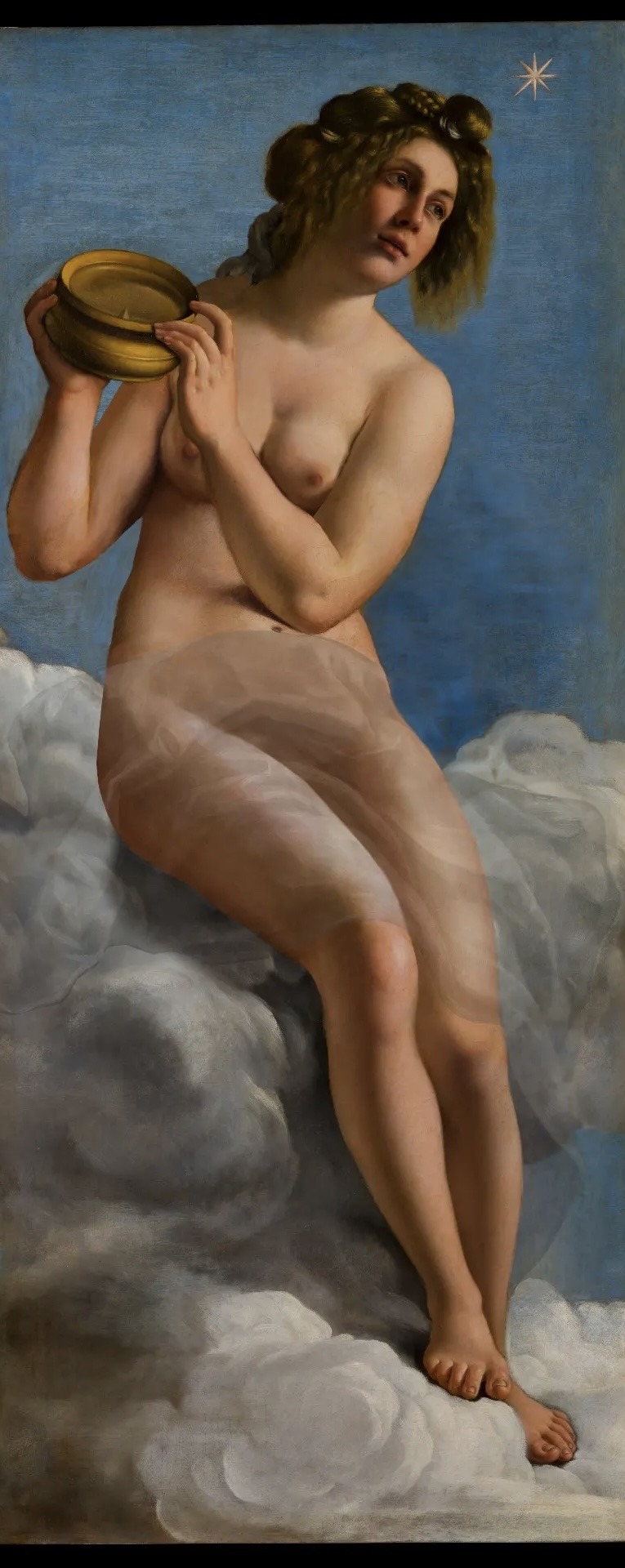
The Inclination
Artemisia Gentileschi
oil on canvas, 1615-1616
Casa Buonarotti
Left: the physical painting in its current condition, with the drapery by Baldassare Franceschini that was commissioned by Leonardo Buonarroti
Right: the digital replica of the uncensored painting as originally painted by Artemisia Gentileschi on commission for Michelangelo Buonarotti the Younger
#digital restoration of painted over paintings is so cool i love it#i really want to learn more about it but midterms are coming up so not right now#the inclination#artemisia gentileschi#1610s#baroque#oil painting#oil on canvas#painting#digital replica#art#art history#casa buonarotti#woman#star#blue
328 notes
·
View notes
Text








Romanticism (2024), Hana Vu, photography by Christopher Ripley and Maegan Houang
Judith Slaying Holofernes (1620), Artemisia Gentileschi | Boy with a Basket of Fruit (1593), Caravaggio | Stańczyk (1862), Jan Matejko | Mary Magdalene as Melancholy (1622-1625), Artemisia Gentileschi
#hana vu#artemisia gentileschi#caravaggio#jan matejko#judith slaying holofernes#boy with basket of fruit#stanczyk#mary magdalene as melancholy#em posts
741 notes
·
View notes
Text



Finished another embroidery/sewing project. This one had a bunch of hiatuses but it’s finally all done! It’s based on Artemisia Gentileschi’s Judith Slaying Holofernes. All of the blood is beadwork. I tried to add a gif of the bloody beads swaying around on the bottom but it kept telling me the gif was too big even though it wasn’t. Ah well.
The progress was recorded on my patreon.
#embroidery#sewing#fabric art#fashion#judith and holofernes#judith slaying holofernes#artemisia gentileschi
578 notes
·
View notes
Text

Artemisia Gentileschi (Italian, 1593-c. 1656): Mary Magdalen in meditation (via Sotheby’s)
#Artemisia Gentileschi#women artists#women painters#early women painters#early women artists#italian painters#religious art#mary magdalene#seventeenth century
193 notes
·
View notes
Text
women artists that you should know about!!
-Judith Leyster (Dutch, 1609-1660)
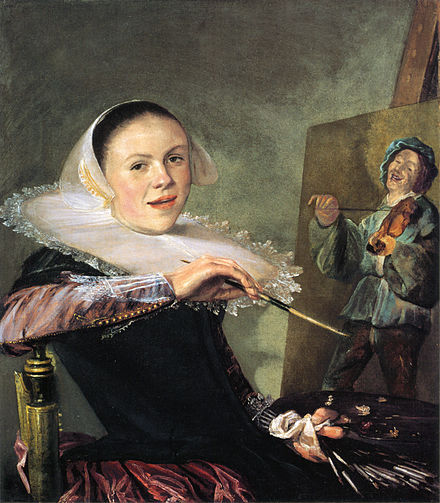
During her life her works were highly recognized, but she got forgotten after her death and rediscovered in the 19th century. In her paintings could be identified the acronym "JL", asually followed by a star, she was the first woman to be inserted in the Guild of St. Luke, the guild Haarlem's artists.
-Artemisia Gentileschi (Italian, 1593-1656)
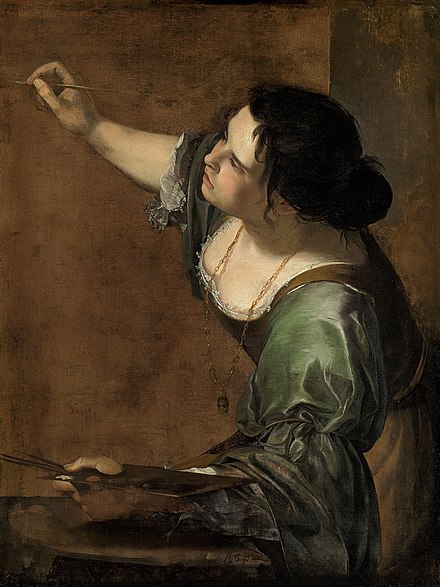
"... Si è talmente appraticata che posso osar de dire che hoggi non ci sia pare a lei, havendo fatto opere che forse i principali maestri di questa professione non arrivano al suo sapere". This is how the father Orazio talked about his nineteen year old daughter to the Medici's court in Florence.
In 1611, Artemisia got raped, and she had to Undergo a humiliating trial, just to marry so that she could "Restore one's reputation" , according to the morality of the time. Only after a few years Artemisia managed to regain her value, in Florence, in Rome, in Naples and even in England, her oldest surviving work is "Susanna and the elders".
-Elisabeth Louise Vigèe Le Brun (French, 1755-1842)

She was a potrait artists who created herself a name during the Ancien Règime, serving as the potrait painting of the Queen of France Marie Antoinette, she painted 600 portraits and 200 landscapes in the course of her life.
-Augusta Savage (Afro-American, 1892-1962)
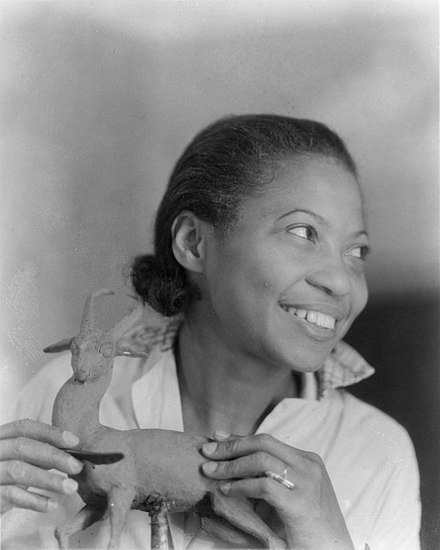
Augusta started making figures when she was a child, which most of them were small animals made out of red clay of her hometown, she kept model claying, and during 1919, at the Palm Beach County Fair, she won $25 prize and ribbon for most original exhibit. After completing her studies, Savage worked in Manhattan steam laundries to support her family along with herself. After a violent stalking made by Joe Gould that lasted for two decades, the stalker died in 1957 after getting lobotomized. In 2004, a public high school, Augusta Fells Savage Institute of Visual Arts, in Baltimore, opened.
-Marie Ellenrieder (German,1791-1863)
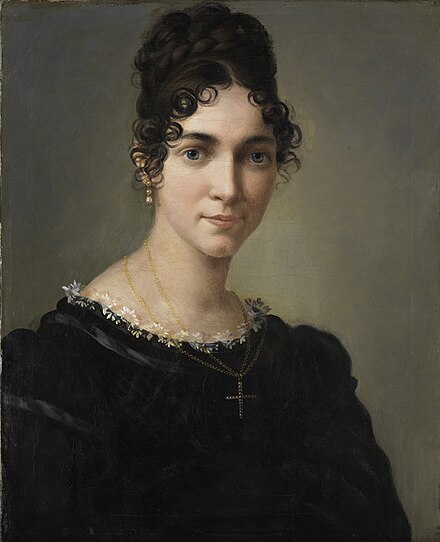
She was known for her portraits and religious paintings. During a two years long stay in Rome, she met some Nazarenes (group of early 19th century German romantic painters who wanted to revive spirituality in art),after becoming a student of Friedrich Overbeck and after being heavily influenced by a friend, she began painting religious image, getting heavily inspired by the Italian renaissance, more specifically by the artist Raphael. In 1829, she became a court painter to Grand Duchess Sophie of Baden.
-Berthe Marie Pauline Morisot (French,1841-1893)

Morisot studied at the Louvre, where she met Edouard Manet, which became her friend and professor. During 1874 she participated at her first Impressionist exhibition, and in 1892 sets up her own solo exhibition.
-Edmonia Lewis or also called "wildfire" (mixed African-American and Native American 1844-1907)

Edmonia was born in Upstate New York but she worked for most of her career in Rome, Italy. She was the first ever African American and Native American sculptor to achieve national and international fame, she began to gain prominence in the USA during the Civil Ware. She was the first black woman artist who has participated and has been recognized to any extent by the American artistic mainstream. She Also in on Molefi Kete Asante's list of 100 Greatest African Americans.
-Marie Gulliemine Benoist (French, 1768-1826)
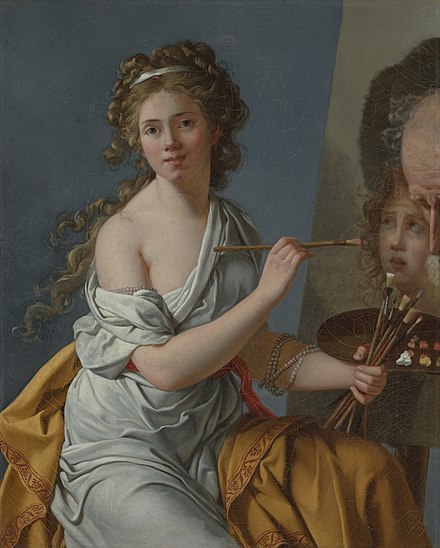
Daughter of a civil servant, Marie was A pupil of Jaques-Louis David, whose she shared the revolutionary ideas with, painting innovative works that have caused whose revolutionary ideals he shared, painting innovative works that caused discussion. She opened a school for young girl artists, but the marriage with the banker Benoist and the political career Of the husband had slowly had effect on her artistic career, forcing her to stop painting. Her most famous work is Potrait of Madeline, which six years before slavery was abolished, so that painting became a simbol for women's emancipation and black people's rights.
-Lavinia Fontana (Italian, 1552-1614)
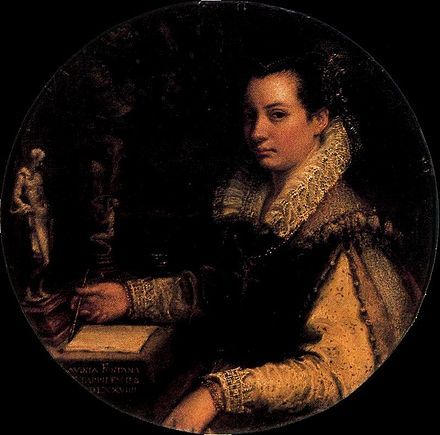
She is remembered for being the first woman artist to paint an altarpiece and for painting the first female nude by a woman (Minerva in the act of dressing), commissioned by Scipione Borghese.
-Elisabetta Sirani. (Italian, 1698-1665)
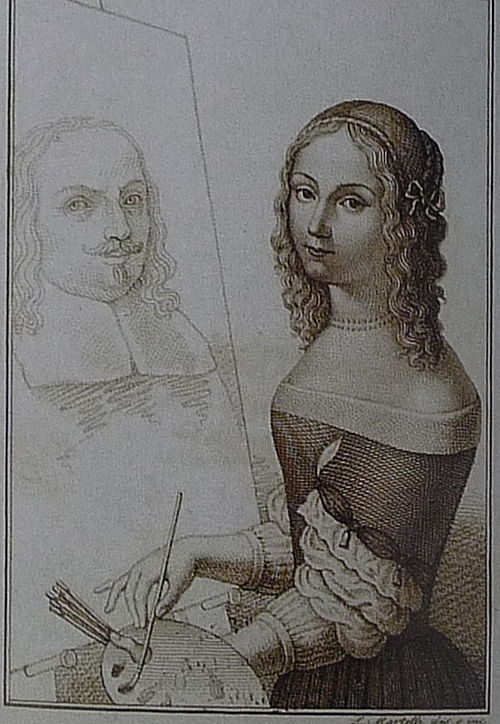
Her admirable artistic skills, that would vary from painting, drawing and engraving, permitted her, in 1660, to enter in the National Academy of S. Luca, making her work as s professor. After two years she replaced her father in his work of his Artistic workshop, turning it into an art schools for girls, becoming the first woman in Europe to have a girls' school of painting, like Artemisia Gentileschi, she represent female characters as strong and proud, mainly drawn from Greek and Roman stories. (ex. Timoclea Kills The Captain of Alexander the Great, 1659).
#judith leyster#artemisia gentileschi#Elisabeth Louise Vigèe Le Brun#Augusta Savage#Marie Ellenrieder#berthe morisot#Edmonia Lewis#Marie Gulliemine Benoist#Lavinia Fontana#Elisabetta Sirani#women artists#renaissance#baroque#art#women in art#artist women#feminism#women history#radical feminists do touch#radical feminists please interact#history#terfblr#terfsafe#cultura#culture
1K notes
·
View notes
Text
Taylor Swift is a Female Rage icon? Get a Grip.
I’ve just received word that Taylor Swift is calling her show “Female Rage: The Musical.” Here is my very much pissed off response to that nonsense:
The phrase, Female Rage has an intimately rich history:
Some of the first accounts of female rage dates to the Italian renaissance. To be clear, women in those days were not allowed to become painters- the arts were seen as the domain of men. They did not believe that women have rich inner lives capable of delivering the type of artistic innovation with which renaissance men were obsessed.
However, rebels abounded, through the might of their fucking rage. Several women created some of the most compellingly emotional paintings I’ve ever fucking seen. They did it without permission, without financial support, and often under the threat of punishment. They did it as a protest. In paintings like “Timoclea Killing Her Rapist” by Elisabetta Sirani (1659), and another by Artemisia Gentileschi “Slaying of Holofernes” (1612) as it depicts the bravery of Judith as she slayed a traveling warlord out to rape Judith and enslave her city. The painting often is referred to as a way Artemisia was envisioning herself as slaying her rapist. These paintings were used against these women as proof that they were unfeminine- and far too angry. Both these women suffered immensely for their audacity to call attention to the violation men perpetrated on them. Female Rage bleeds off these paintings- bleeds right through to the bone-deep acknowledgement of the injustice women faced being barred from the arts and having their humanity violated in such a sick way. Both women were hated- and considered far too angry.
In philosophy, also as early as the 15th century, an example of female rage is a philosophical text, often hailed as one of the first feminists works in the western world, written by Christine de Pizan titled The City of Ladies (1405). She wrote in protest on the state of women- writing that “men who have slandered the opposite sex out of envy have usually know women who were cleverer and more virtuous than they are” (“The City of Ladies”). People mocked her all her life- but she stood fast to her convictions. She was widowed at a young age with children to feed and the men wouldn’t let women have jobs! She wrote this book and sold it so that she could feed her family- and to protest the treatment of women as lesser than men. Her work was called aggressive and unkempt- they said she was far too angry.
In the 18th century, a young Mary Wollstonecraft wrote, A Vindication of the Right of Women ( 1792) upon learning that the civil rights won in the French Revolution did not extend to women! She wrote in protest of the unjust ways other philosophers (like Rousseau) spoke about the state of women- as if they were lesser. She wrote to advocate for women’s right to education, which they did not yet have the right to! She wrote to advocate for the advancement of women’s ability to have their own property and their own lives! The reception of this text, by the general public, lead to a campaign against Wollstonecraft- calling her “aggressive” and far too angry.
Moving into modernity, the 1960’s, and into literary examples, Maya Angelou publishes I know why the caged Bird Sings (1969) in which she discusses the fraught youth of a girl unprotected in the world. It beautifully, and heart-wrenchingly, described growing up in the American South during the 1930’s as it subjected her to the intersection of racism and sexism. The story is an autobiographical account of her own childhood, which explains how patriarchal social standards nearly destroyed her life. Upon the reception of her book, men mostly called it “overly emotional” and far too angry. Maya Angelou persisted. She did not back down from the honesty with which she shared her life- the raw, painful truth. With Literature, she regained a voice in the world.
Interwoven into each of the examples I have pulled out here, is the underlying rage of women who want to be seen as human beings, with souls, dreams and hopes, yet are not seen as full members of society at the behest of men. They take all that rage, building up in their souls, and shift it to create something beautiful: positive change. Each of these cases, I have outlined above, made remarkable strides for the women as a whole- we still feel the impact of their work today. They were so god-damn passionate, so full of righteous anger, it burst out into heart-stopping, culture-shifting art. Feminine rage is therefore grounded in experiences of injustice and abuse- yet marked too by its ability to advocate for women's rights. It cannot be historically transmogrified away from these issues- though Taylor Swift is doing her best to assert female rage as pitifully dull, full of self-deprecation, and sadness over simply being single or losing money. She trivializes the seriousness with which women have pled their cases of real, painful injustice and suffering to the masses time and time again. The examples above deal with subjects of rape, governmental tyranny, and issues of patriarchally inspired social conditioning to accept women as less human than men. It is a deadly serious topic, one in which women have raised their goddamn voices for centuries to decry- and say instead, “I am human, I matter, and men have no right to violate my mind, body, or soul.”
The depictions of female rage over the last few centuries, crossing through many cultures, is an array of outright anger, fearsome rage, and into utter despair. The one unyielding, solid underpinning, however, is that the texts are depicting the complete agency of the women in question. The one uniting aspect of female rage is that it must be a reaction to injustice; instead of how male depictions of female rage function, (think Ophelia), the women are the agents of their art with female made- female rage. They push forth the meaning through their own will- not as subjects of male desires or abuses, but as their own selves. That is what makes the phrase so empowering. They are showing their souls as a form of protest to the men who treat women like we have no soul to speak of.
Taylor Swift’s so-called female rage is a farce in comparison. Let’s look at an example: “Mad Woman” (2020). I pull this example, and not something from her TTPD set, because this is one of the earliest examples of her using the phrase female rage to describe her dumb music. (Taylor Swift talking about "mad woman" | folklore : the long pond studio sessions (youtube.com)
The lyrics from “Mad Woman” read “Every time you call me crazy, I get more crazy/... And when you say I seem angry, I get more angry”
How exactly is agreeing with someone that you are “crazy” a type of female rage in which she’s protesting the patriarchy. The patriarchy has a long history of calling women “insane” if they do not behave according to the will of men. So, how is her agreeing with the people calling her crazy- at all subversive in the way that artworks, typically associated with concept of female rage, are subversive. What is she protesting? NOTHING.
Then later, she agrees, again, that she's “angry.” The issue I draw here is that she’s not actually explicating anything within the music itself that she’s angry about- she just keeps saying she's angry over and over, thus the line falls flat. The only thing this anger connects to is the idea of someone calling her angry- which then makes her agree that she is... angry. So, despite it being convoluted, it’s also just not actually making any kind of identifiable point about society or the patriarchy- so again, I beg, what on Earth makes this count as Female Rage?
In essence, she is doing the opposite of what the examples above showcase. In letting an outside, presumably male, figure tell Taylor Swift what she is feeling, and her explicit acceptance of feeling “crazy” and “angry,” she is ultimately corroborating the patriarchy not protesting it. Her center of agency comes from assignment of feelings outside of herself and her intrinsic agreement with that assignment; whereas female rage is truly contingent on the internal state, required as within our own selves, of female agency. As I stated above, the women making female rage art must have an explicit agency throughout the work. Taylor Swift’s song simply does not measure up to this standard.
Her finishing remarks corroborates the fact that she's agreeing with this patriarchal standard of a "mad" or crazy woman:
"No one likes a mad woman/ You made her like that"
Again, this line outsources agency through saying "you made her like that" thus removing any possibility of this song being legitimate female rage. There is simply no agency assigned to the woman in the song- nor does the song ever explicitly comment on a social issue or protestation of some grievous injury to women's personhood.
She honestly not even being clever- she's just rhyming the word “crazy” with “crazy.” Then later rhyming “angry” with “angry.” Groundbreaking stuff here.
Perhaps Taylor Swift is angry, in “Mad Woman,” but it is not the same type of rage established in the philosophical concept of female rage of which art historians, philosophers, and literary critics speak. Instead, it is the rage of a businesswoman that got a bad deal- but it is not Female Rage as scholars would identify it. In “Mad Woman” I fear her anger is shallow, and only centered on material loss- through damaging business deals or bad business partners. She is not, however, discussing what someone like Christine de Pizan was discussing by making a case for the concept that woman also have souls like men do. In her book, she had to argue that women have souls, because men were unconvinced of that. Do you see the difference? I am saying that Swift’s concerns are purely monetary and material, whereas true examples of female rage center on injustice done against their personhood- as affront to human rights. Clearly, both things can make someone mad- but I’d argue the violation of human rights is more serious- thus more deserving of the title “Female Rage.”
Simply put, Taylor Swift is not talking about anything serious, or specific, enough to launch her into the halls of fame for "Female Rage" art. She's mad, sure, but she's mad the way a CEO gets mad about losing a million dollars. She's not mad about women's position in society- or even just in the music industry.
She does this a lot. The album of “Reputation” was described as female rage. Songs in “Folklore” were described as female rage. Now, she’s using the term to describe TTPD, which is the most self-centered, ego-driven music I’ve heard in a long time.
Comparing the injustice, and complete subjugation, of women’s lives- to being dumped by a man or getting a bad deal- wherein she is still one of the most powerful women of the planet- is not only laughable, but offensive.
#anti taylor swift#taylor swift critical#ex swiftie#mad woman#folklore#maya angelou#christine de pizan#artemisia gentileschi#mary wollstonecraft#Elisabetta Sirani#art history#books and literature#feminist#feminism#female rage#taylor swift#activism#toxic swifties#toxic taylor swift#philosophy#fuck Rousseau#I'm a professional Taylor Swift Critic
629 notes
·
View notes
Text

soooo i've been real busy this past month and change working on this monster of a painting! it was originally for the GO Ref library study club but clearly took much longer than i anticipated😅
for those of you who don't recognize it, this is based on one of my favorite historical paintings, Judith Beheading Holofernes (1620) by Artemisia Gentileschi. i love the Baroque period and this painting (as well as her other works) makes me insane. here it is Good Omens style so maybe all of you can be insane with me <3
"Aziraphale (and Crowley) Beheading the Metatron"
(non-bloody and non-glowy versions under the cut)
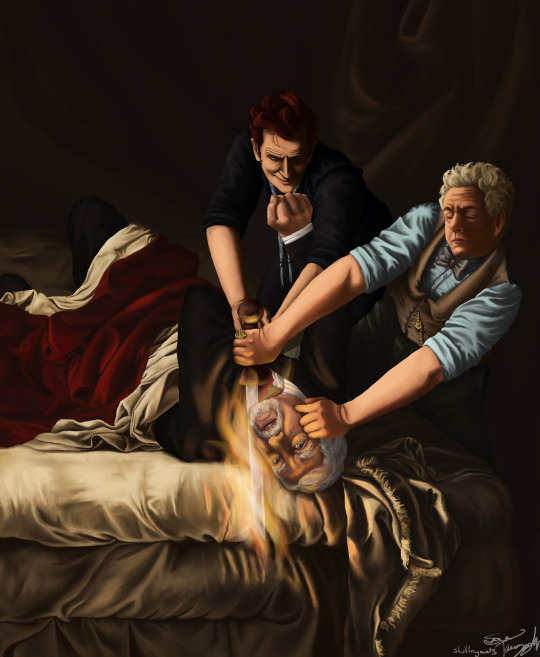
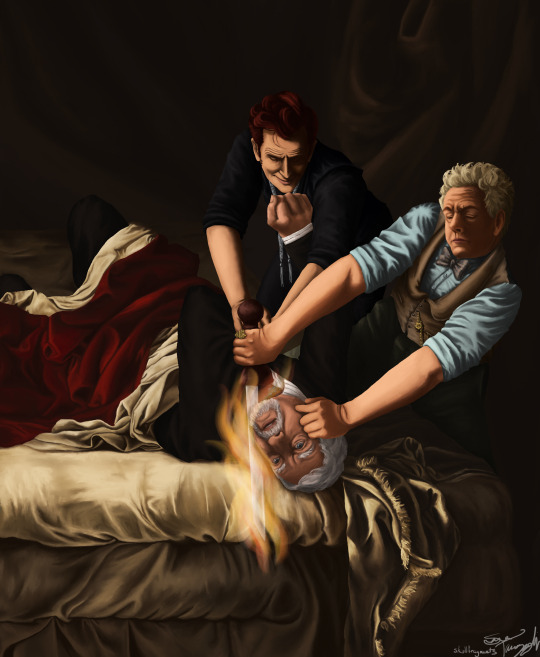
#IT'S DONE#can i get a wahoo#dear tumblr pls don't fuck up the quality#sara does art#good omens#good omens fanart#shout out to the GORL server!!!#crowley#aziraphale#aziracrow#the metatron#OFF WITH HIS HEAD#i will never attempt digital oil painting again#(pls stop me if i do)#artemisia gentileschi#ITALIAN BAROQUE QUEEN#italian baroque#i need you all to know that the suggested tag that came up was 'italian barty crouch jr.'#david tennant you're already in this picture that's enough#baroque art#judith beheading holofernes#the superior version btw#tw blood#didn't you have a flaming sword? it was flaming like anything#if u zoom in pls appreciate the tartan bowtie detail#that shit took me way longer than it should have#as well as the approx 15hrs each i spent on azi's sleeves#did i miss any tags??#ART#i'm going to hibernate now thank you
608 notes
·
View notes
Text
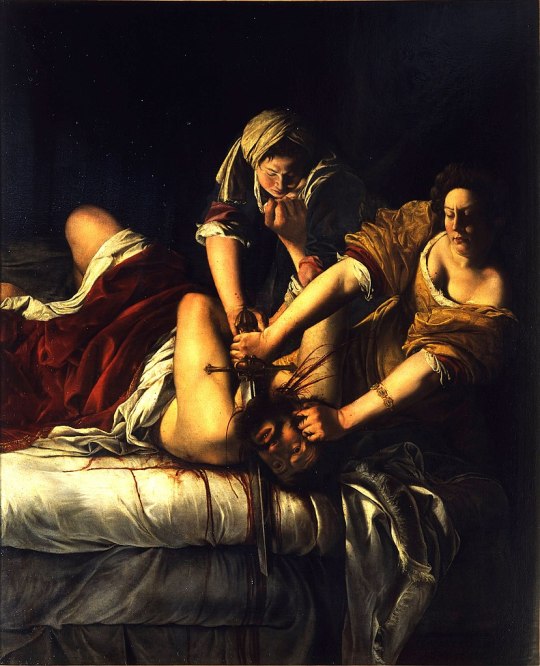
Judith Slaying Holofernes (c. 1612)
Artemisia Gentileschi
#international women's rights day#international women's day#judith slaying holofernes#artemisia gentileschi#feminism#misandry#art#herstory#fuck the patriarchy#femminismo#8th march
660 notes
·
View notes
Text
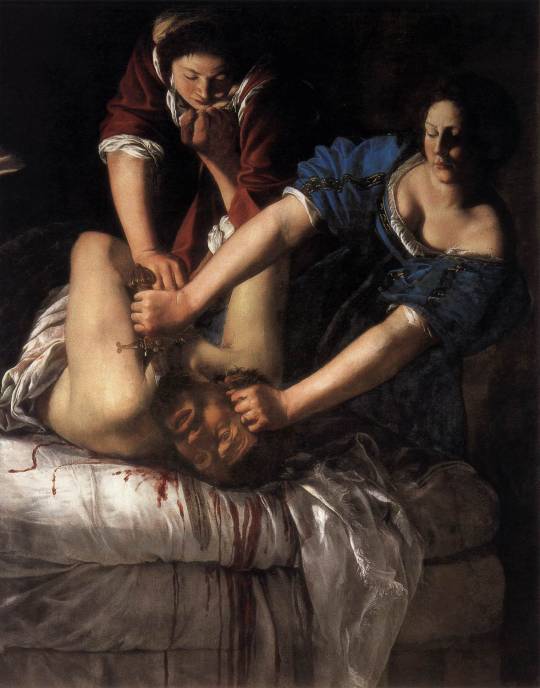
Judith Slaying Holofernes - Artemisia Gentileschi
#dark academia#classical art#art academia#judith slaying holofernes#artemisia gentileschi#baroque#caravaggio#romantic academia#dark academia aesthetic#classic academia#classical academia
2K notes
·
View notes
Text
Hey how about some ART TALK
Art history is a bit of a hobby of mine. Last weekend I went to the Frick in Pittsburgh because they had a special exhibition we wanted to see, and in the gift shop I picked up a book that told the story of a series of acknowledged masterpieces. The first one in the book is Birth of Venus, the second is Mona Lisa, and the scream I scrumpt when I turned the page to see the third:

Let me tell you about Artemisia Fucking Gentileschi.
She was a 17th century painter and one of the first women to be admitted to a Florentian art society and is widely regarded as one of the finest of the Italian baroque painters. She was raised by her father, who was also a painter who studied Caravaggio, and early in her career she had to put up with people saying that her paintings surely must have been painted by her father (despite her father himself saying she was a peerless artist and super accomplished).
As a young woman she was raped by a colleague of her father's. Her father sued the rapist because he hadn't married her (THIS was the crime, not the rape itself, of course) and Artemisia was tortured with thumbscrews to verify her testimony. Some of the...ahem...feelings about this entire episode definitely come through in her work.
Contrary to how these stories usually go, Artemisia had a long and productive career, was well paid for her work, enjoyed the patronage of the Medici family, and traveled widely. History, however, has only recently come to appreciate her and name her among the great painters of the period.
Let's talk about THIS FUCKING PAINTING, though. Judith Beheading Holofernes. Probably her most famous work.

The story is one of Judith, a Jewish woman, who got the general of the army about to invade her city to come have dinner with her, got him drunk, and chopped his head off. Then she paraded his head out to the army, like a boss. It's been painted a number of times but this one...this one really brings the rage. Look at Judith, the strength in her arms, how she's got a look of steely concentration. If you look closely, you can see she has her knee up on the bed behind him to get more leverage. Her maidservant is helping hold him down. Neither of them look horrified or hesitant, they're ready to cut this motherfucker. (also that's definitely Artemisia as Judith. She put herself in a lot of her paintings)
It's an apt interpretation of the verse from the Book of Judith, which is admiringly succinct:
Her sandal ravished his eye, Her beauty made captive his soul, The sword passed through his neck. —���Book of Judith, 16:9[7]
It's got a real "the tiger is out" energy, right?
Now let's look at the same scene, painted by Caravaggio, who was no slouch at painting, but...come on.

Judith looks like a scared teenager. She's holding him at arm's length as if that's gonna work. Her maid is a crone, lurking at her shoulder like Wormtongue. This does not, imho, compare to the power of Gentileschi's version.
Artemisia painted another image of Judith holding the severed head. And a lot of other paintings. I'm just thrilled to see this one in this book, as it's one of my favorites. We have one of her paintings here in Columbus and I always visit it when I go (when it's up, that is).
369 notes
·
View notes